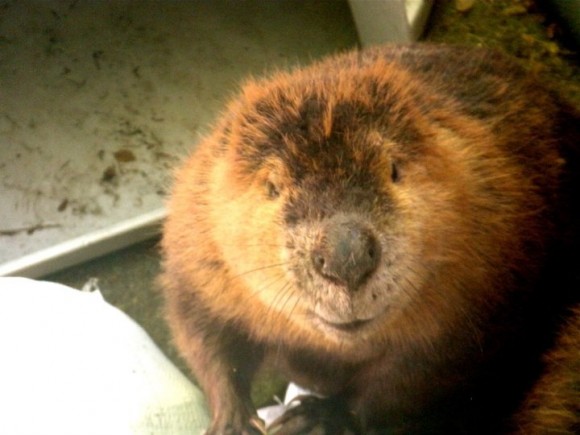
Leave It to the Beaver!
by: The Lands Council: Kat Hall and Amanda Parrish Posted on: October 06, 2011
By Kat Hall (The Lands Council’s Conservation Programs Director) and Amanda Parrish (The Beaver Solution Contact)
Editor’s Note: Want to know how reintroducing beavers can generate wetlands, help supply consistent late-season stream flows for fish and farmers, clean water and provide habitat? Check out this piece from The Land’s Council, who is getting paid to do just this.
The Lands Council (TLC)—a non-profit organization based in Spokane, WA whose mission is to preserve and revitalize the forests, water, and wildlife of the Inland NW—truly is “leaving it to the beaver.”
Simply put, this means letting beavers do what they do best: build dams that provide key ecosystem benefits. Beaver dams store spring runoff, create wetlands, provide fish and wildlife habitat, and improve water quality. The Lands Council’s long-term vision is to re-introduce beaver to appropriate watersheds—starting in the Columbia River Basin and eventually expanding into the western United States—where they will store millions of acre-feet of water and create thousands of acres of wetlands and wildlife habitat.
Prior to the colonization of North America by European settlers, it is estimated that beavers numbered close to half a billion on the continent, with up to 8 million in Washington State alone. They were present in every watershed and directly influenced total wetland area through dam creation and water storage, thus, beaver restoration can greatly increase wetland creation. A Minnesota study found that as beaver populations increased over a 46-year period, the total area of land flooded by beaver dams went from 1% to 13% of the landscape. It is estimated by TLC that restoration of 1 million beaver could see the development of an additional 2-3 million acres of wetlands in the upper reaches of Columbia River watersheds.
Beaver act as natural ecosystem engineers, profoundly impacting stream hydrology, sediment transport, vegetation, water storage, and late-season stream flows. They build dams and construct natural wetland reservoirs that store and slowly release spring runoff. The stored water seeps out throughout the year and increases late-season flows for downstream benefits. The value of each acre-foot of available water storage or each additional cubic foot per second flow that results from the shifted hydrograph depends on when and where the water is available, but can be thousands of dollars per acre-foot.
The U.S. has a no net loss policy regarding wetlands. When a company wants to fill an existing wetland for development, they are responsible for providing wetlands to offset the loss. Wetland credits, because of their ability to store and filter water, have traded from as little as $4,000 to as much as $125,000 per acre of wetland. Beaver-created wetlands also help reduce flooding effects on downstream landowners, as the wetland acts like a buffer for the flood plain. Natural biogeochemical processes that sequester phosphorus in sediments and can remove 40-50% of incoming phosphorus is another attribute of wetlands, which benefits water quality. Wetlands also provide habitat for a myriad of species, such as migratory waterfowl, juvenile fish, amphibians, and mammals.
A key objective of TLC’s project is to show that beaver can be successfully re-introduced, and that they will provide the dual benefits of water storage and wetlands creation. In 2010 TLC obtained equipment and training and were successful at trapping a total of 28 beaver and moving intact families to four suitable locations. Beaver families can include up to approximately 10 members. Beaver are monogamous and mate for life. Most kits remain with the adults until they are almost two years old. Monitoring of the 2010 re-introductions is underway, and two families are already building dams. Four locations have been selected for beaver re-introduction in 2011 and have approval from the landowners and land managers, who will ultimately help manage the sites. So far this year two beaver families have been relocated, both in the Colville National Forest. A conservative estimate by TLC suggests that 100 acres of new wetlands would be created within 5 years from the 2010 re-introductions, and another 100 acres of wetlands from the 2011 re-introductions.
TLC’s project is an on-the-ground application that takes both the historical significance of beaver and the need to increase wetlands and water storage and combines it with the social and physical challenges for restoring a species into a habitat that has been altered by humans. By looking at downstream water users, such as agriculture, salmon recovery agencies, municipalities, and utilities, TLC believes it can create a model of cooperation and funding sources to turn its pilot project into a landscape-scale restoration project with multiple ecosystem benefits.
That’s leaving it to the beaver.
Visit www.landscouncil.org
Articles On Fauna
Fauna: Fauna
- Dec 4 Rapid Evolution and Adaptation to Climate Change: Salmon
- Sep 4 Orca Tribes of the Salish Sea and Beyond
- Jun 11 The Secret Life of Plastic
- Apr 29 The Tongass: The National Salmon Forest
- Jan 6 Oysters and Ocean Acidification
- Oct 6 Leave It to the Beaver!
- Sep 8 A New Trend in Dam Removal?
- Aug 31 There’s a New Bug in Town
- Jan 7 A History Lesson Concerning Fauna
- Oct 24 Salmon, Dams and the Snake River
- Oct 21 The Return of Washington’s Wolf Packs?
- Oct 21 A Fauna the WSDA isn’t Too Fond Of

